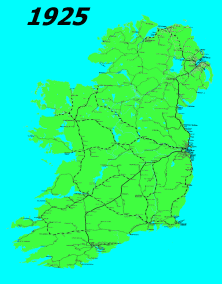
A railcar is a self-propelled railway vehicle designed to transport passengers. The term "railcar" is usually used in reference to a train consisting of a single coach, with a driver's cab at one or both ends. Some railway companies, such as the Great Western, termed such vehicles "railmotors".

The Dublin Area Rapid Transit system is an electrified commuter rail railway network serving the coastline and city of Dublin, Ireland. The service makes up the core of Dublin's suburban railway network, stretching from Greystones, County Wicklow, in the south to Howth and Malahide in north County Dublin. The DART serves 31 stations and consists of 53 route kilometres of electrified railway, and carries in the region of 20 million passengers per year. In a similar manner to the Berlin S-Bahn, the DART blends elements of a commuter rail service and a rapid transit system.

An electric locomotive is a locomotive powered by electricity from overhead lines, a third rail or on-board energy storage such as a battery or a supercapacitor. Locomotives with on-board fuelled prime movers, such as diesel engines or gas turbines, are classed as diesel-electric or gas turbine-electric and not as electric locomotives, because the electric generator/motor combination serves only as a power transmission system.

The history of rail transport in Ireland began only a decade later than that of Great Britain. By its peak in 1920, Ireland had 3,500 route miles (5,630 km). The current status is less than half that amount, with a large unserviced area around the border area between Northern Ireland and The Republic of Ireland.

Rail transport in Ireland is provided by Iarnród Éireann in the Republic of Ireland and by Northern Ireland Railways in Northern Ireland.
The Great Southern Railways Company was an Irish company that from 1925 until 1945 owned and operated all railways that lay wholly within the Irish Free State.

The 'NIR 101 Class ' is a class of diesel-electric locomotive formerly operated by Northern Ireland Railways (NIR). With the return to the working of the Enterprise service from Belfast to Dublin with coaching stock instead of augmented diesel railcar sets, NIR found itself with no suitable main line diesel locomotives. The 101 Class became the answer to the immediate problem working in conjunction with the newly acquired British Rail Mark 2 coaches.

The Córas Iompair Éireann 121 Class was a railway locomotive which was manufactured by General Motors Electro-Motive Division. These locomotives were in regular service on the Irish railway network until 2002, with the last two remaining in service until early 2008.

The CIE 141 Class locomotives were built in 1962 by General Motors Electro Motive Division (EMD) in the United States. Numbered B141 to B177, they were an updated version of the 121 Class locomotives, mechanically very similar but with cabs at each end.

The NZR RM class Edison battery-electric railcar was a railcar that ran in Canterbury, New Zealand for eight years. It was built for New Zealand Railways (NZR) as a prototype for battery-electric railcars. While the railcar, classified "RM 6", was considered the first successful railcar in New Zealand, it was later destroyed in a fire, and battery-electric traction for railcars was not developed further in New Zealand. Two other classes of battery-electric locomotives were introduced about the same time as RM 6, the E class of 1922 and the EB class of 1925.

A nickel–zinc battery, abbreviated NiZn, is a type of rechargeable battery similar to NiCd batteries, but with a higher voltage of 1.6 V.

The Harcourt Street Railway Line was a railway line that ran from Harcourt Street in Dublin through the southern suburbs to Bray. It was one of the Dublin and South Eastern Railway's two northern main lines, the other being the Coastal Line to Westland Row.
A hybrid train is a locomotive, railcar or train that uses an onboard rechargeable energy storage system (RESS), placed between the power source and the traction transmission system connected to the wheels. Since most diesel locomotives are diesel-electric, they have all the components of a series hybrid transmission except the storage battery, making this a relatively simple prospect.

The Mallow–Tralee line runs from Mallow to Tralee Casement. Intermediate stations include Banteer, Millstreet, Rathmore, Killarney and Farranfore.

A battery electric multiple unit (BEMU), battery electric railcar or accumulator railcar is an electrically driven multiple unit or railcar whose energy is derived from rechargeable batteries driving the traction motors.

The Córas Iompair Éireann (CIÉ) 2600 Class were Associated Equipment Company (AEC)–engined diesel multiple units that operated InterCity and suburban services on the CIÉ system between 1952 and 1975. Many were later converted for push–pull operation with diesel locomotives, finally being withdrawn when displaced by the electric Dublin Area Rapid Transit service in the mid-1980s.

Inchicore railway works, also known locally as 'Inchicore' or 'The Works', was founded by the Great Southern and Western Railway in 1846 and emerged to become the major engineering centre for railways in Ireland. Located c. 3 km west of Dublin city centre, the works cover an area of approximately 73 acres (300,000 m2).

James Joseph Drumm was an Irish chemist and the inventor of the Drumm battery.

The Casino Model Railway Museum at Malahide, Ireland is the display home for the Fry Model Collection in the refurbished Casino cottage building in central Malahide. It opened to the public on 22 January 2020.
The Great Southern Railways (GSR) Class 670 consisted of five 0-6-2T tank locomotives built by Inchicore railway works in 1933 for suburban services south of Dublin to Bray and Greystones.
















